
7 Best Gmail CRM System Options for 2025 (In-Depth Review)
Discover the 7 best Gmail CRM system options to streamline your workflow. Compare features, pricing, and pros/cons to find the perfect fit for your team.
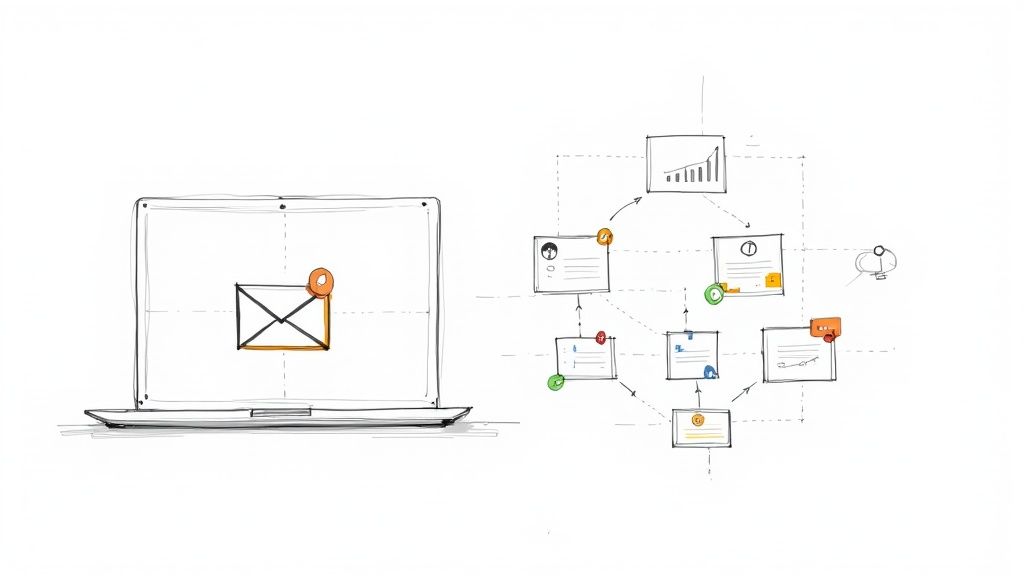
Your Gmail inbox is more than just a place to send and receive messages; it's the central hub of your business communication. For project managers, sales teams, and small business owners, manually tracking customer interactions, sales pipelines, and project tasks directly within Gmail is inefficient and prone to error. This is the exact problem a Gmail CRM system is designed to solve. By integrating directly into your inbox, these tools transform Gmail from a simple communication platform into a powerful, centralized relationship management command center.
This guide eliminates the guesswork in finding the right solution for your workflow. We will dive deep into the best Gmail CRM platforms available, evaluating each one's core features, pricing structures, and unique advantages. You'll find a detailed breakdown of tools like Streak, HubSpot, Copper, and more, complete with screenshots and direct links to help you make an informed decision quickly.
For each system, we'll explore its specific implementation within the Google Workspace environment, providing actionable insights into how it can streamline your processes. To truly maximize the potential of your chosen CRM, it's crucial to connect with customers on a deeper level. To fully leverage your Gmail CRM's capabilities and enhance customer engagement, delve into the ultimate guide to email marketing personalization for data-driven strategies. Let's find the perfect system to unify your inbox and drive your business forward.
1. Tooling Studio
Tooling Studio stands out as a powerful and elegantly simple solution for professionals seeking to transform their Gmail inbox into a centralized command center. It achieves this through a suite of lightweight Chrome extensions that embed task and project management directly within the Google Workspace ecosystem. This approach eliminates the friction of switching between applications, allowing you to manage workflows without ever leaving the familiar context of Gmail, Google Tasks, or Google Contacts.
Its flagship extension, Kanban Tasks, reimagines Google Tasks as a dynamic and visual Kanban board. This feature is a game-changer for organizing work, as it enables intuitive drag-and-drop task management, shared boards for team projects, and real-time updates. You can turn an email into an actionable task with a single click, add detailed comments, attach relevant files, and assign duties to team members, all within your inbox. This native integration creates a seamless, distraction-free environment that significantly boosts productivity.
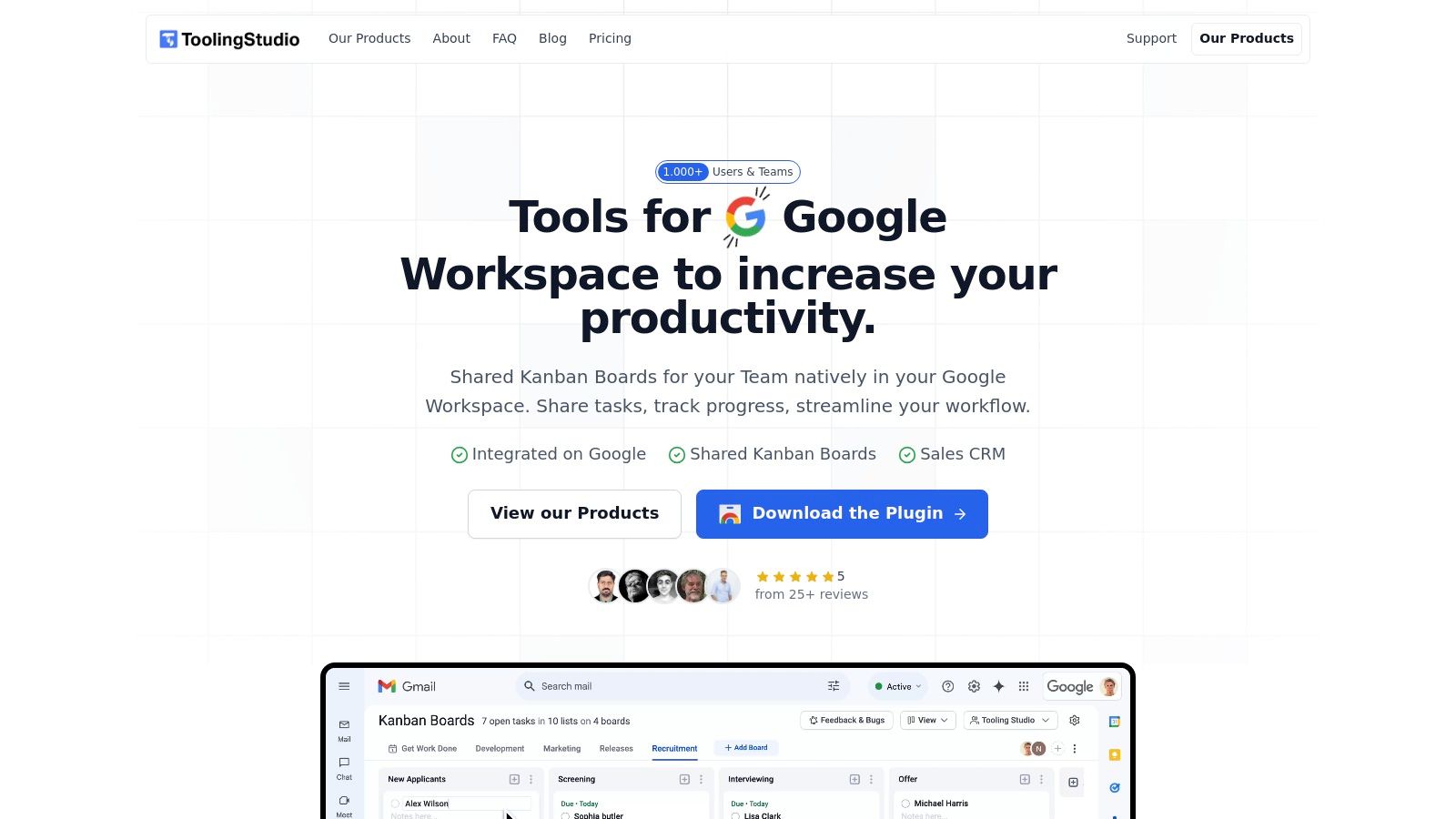
Why Tooling Studio is an Excellent Gmail CRM System
While its core strength lies in task management, Tooling Studio is rapidly evolving into a comprehensive gmail crm system with the development of its Sales CRM extension, currently in beta. This new module applies the same principle of native integration to sales pipelines, tracking leads, deals, and customer interactions directly linked to Google Contacts. This centralizes customer relationship management where it matters most: inside your primary communication tool.
The platform is trusted by over 1,000 users and teams, from solo freelancers to large enterprises, who praise its clean user interface and immediate impact on efficiency. Security is also a top priority, with robust encryption and secure authentication protocols ensuring your sensitive data remains protected within the Google Workspace framework.
Key Insight: Tooling Studio's philosophy is not to replace your Google tools but to enhance them. By building directly on top of platforms like Gmail and Google Tasks, it provides a near-native experience that feels like a natural extension of the tools you already use daily, minimizing the learning curve and maximizing adoption.
Standout Features and Implementation
- Native Kanban Boards: Visualize your projects and tasks directly in Gmail. Create shared boards for your team to track progress on sales leads, marketing campaigns, or client projects.
- Email-to-Task Conversion: Instantly convert any email into a task on your Kanban board. This ensures no follow-up is missed and keeps your inbox clean.
- Rich Task Management: Enhance tasks with comments, file attachments, custom tags, and due dates to provide full context and clarity for your team.
- Integrated Sales CRM (Beta): The upcoming Sales CRM extension promises to bring deal tracking, lead management, and contact history into your Google Workspace, creating a unified system for sales activities. Understanding the benefits of this integrated approach is key; you can read more about how a Gmail CRM integration works on Tooling Studio's blog.
Pros and Cons
| Pros | Cons |
|---|---|
| Seamless Native Integration: Works directly within Gmail and Google Workspace, eliminating app switching. | Browser Limitation: Currently exclusive to the Google Chrome browser. |
| Intuitive and Visual: The Kanban board interface with drag-and-drop functionality is extremely easy to use. | CRM in Beta: The full-featured Sales CRM is still in development, so some advanced features are not yet available. |
| Strong User Trust: Highly rated by its user base for boosting productivity with a clean, effective design. | |
| Active Development: Continuously updated with new features based on direct user feedback. | |
| Robust Security: Leverages Google's infrastructure for secure authentication and data encryption. |
Getting Started
Tooling Studio offers a free trial, allowing you to experience its productivity benefits firsthand. Installation is a straightforward process of adding the Chrome extension from the Chrome Web Store. Once installed, it integrates automatically into your Gmail interface.
Website: https://tooling.studio
2. Streak CRM
Streak CRM distinguishes itself by being one of the only CRMs built directly into the Gmail interface, rather than simply integrating with it. This unique approach transforms your inbox into a fully functional and flexible workspace, eliminating the need to constantly switch between your email and a separate CRM tab. It’s an ideal gmail crm system for individuals and small teams who live in their inbox and want to manage sales pipelines, contacts, and projects without disrupting their existing workflow.
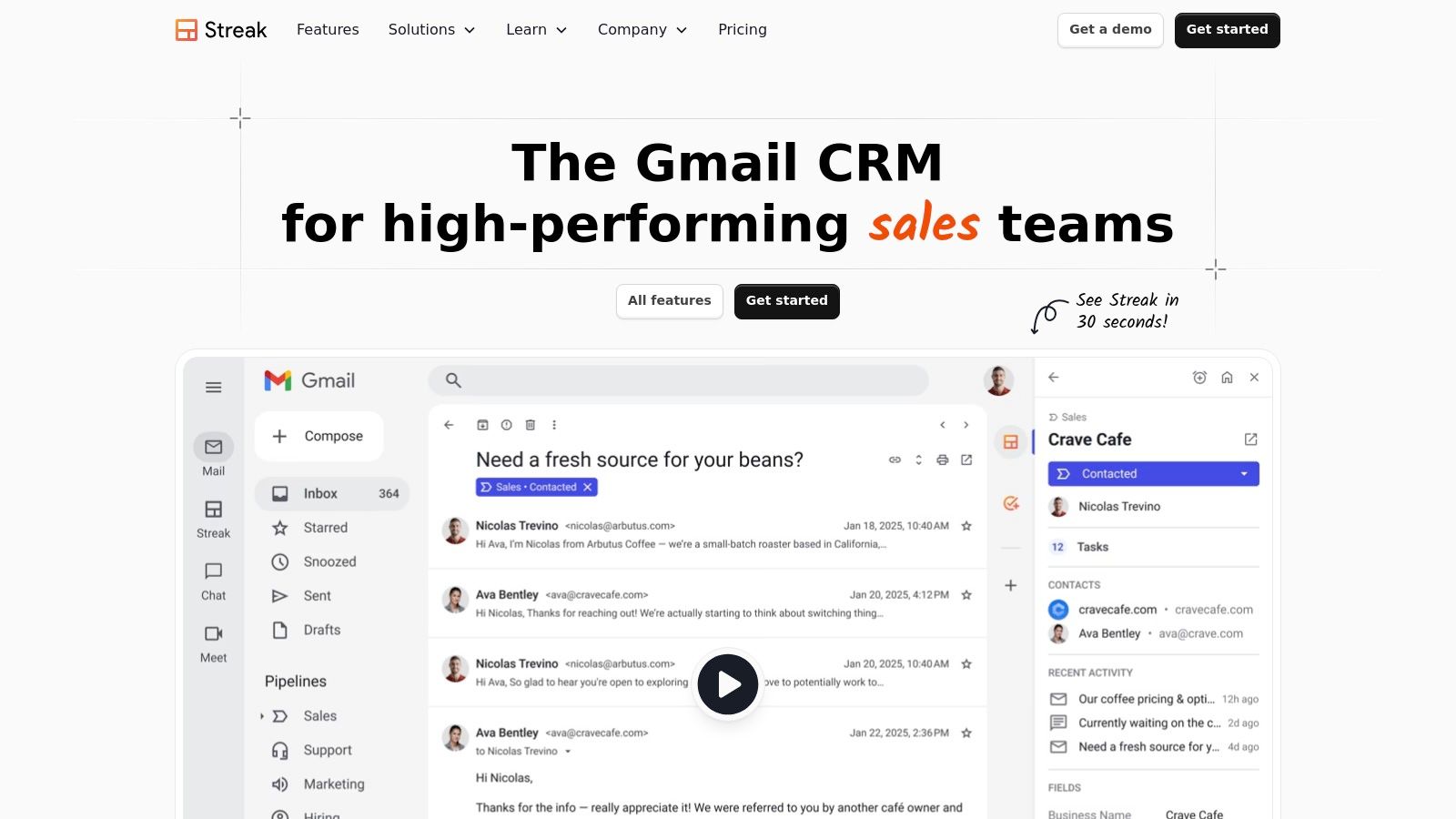
The platform’s core strength lies in its customizable "pipelines," which are essentially visual workflows that you can tailor for any process, from sales and business development to hiring and support. Emails related to a specific contact or deal are automatically grouped into "boxes," providing a complete, chronological history of all interactions at a glance.
Key Features and Benefits
- Native Gmail Experience: Manage everything from pipelines to contacts directly within Gmail. The user interface feels like a natural extension of Google's design, making it intuitive for new users.
- Email Power Tools: Enhance your outreach with built-in email tracking, mail merge, and scheduling. See exactly when recipients open your emails and send personalized follow-ups in bulk.
- Flexible Pipelines: Use pre-built templates for sales, real estate, or hiring, or create custom stages to match your unique business process perfectly.
- Team Collaboration: Share pipelines, emails, and notes with your team. Avoid duplicate work and ensure everyone has the most up-to-date information on any given deal or project.
Practical Tip: Use Streak’s "Snippets" feature to save and reuse frequently sent emails. This saves significant time when responding to common inquiries or sending follow-up messages, ensuring consistency in your team's communication.
Pricing and Plans
Streak offers a generous Free plan that includes basic CRM features, 500 pipeline boxes, and 50 mail merge sends per day, making it highly accessible for freelancers and startups. For more advanced needs, paid plans start with the Solo plan at $15 per user/month, adding more pipeline items and features. The Pro plan ($49 per user/month) unlocks advanced CRM functions and shared pipelines, while the Enterprise plan ($129 per user/month) provides custom permissions and dedicated support.
Pros & Cons
| Pros | Cons |
|---|---|
| Unbeatable native Gmail integration | Reporting is limited on lower-tier plans |
| Very intuitive and easy to learn | Can slow down Gmail if many pipelines are active |
| Excellent free plan for individuals | Fewer integrations compared to standalone CRMs |
| Highly customizable workflows |
For those looking for a truly seamless way to manage relationships from their inbox, Streak is a top-tier choice. For a more detailed comparison of how Streak stacks up against other options, you can learn more about CRM solutions for Gmail.
Website: https://www.streak.com/
3. HubSpot CRM
HubSpot CRM is a powerhouse in the customer relationship management space, offering a comprehensive suite of tools that extends far beyond a simple inbox integration. While not built into Gmail like some competitors, its seamless connection through a Chrome extension brings essential CRM functionality directly to your email interface. This makes it an exceptional gmail crm system for businesses of all sizes, especially those planning for growth, who need a scalable platform that unites sales, marketing, and service activities.
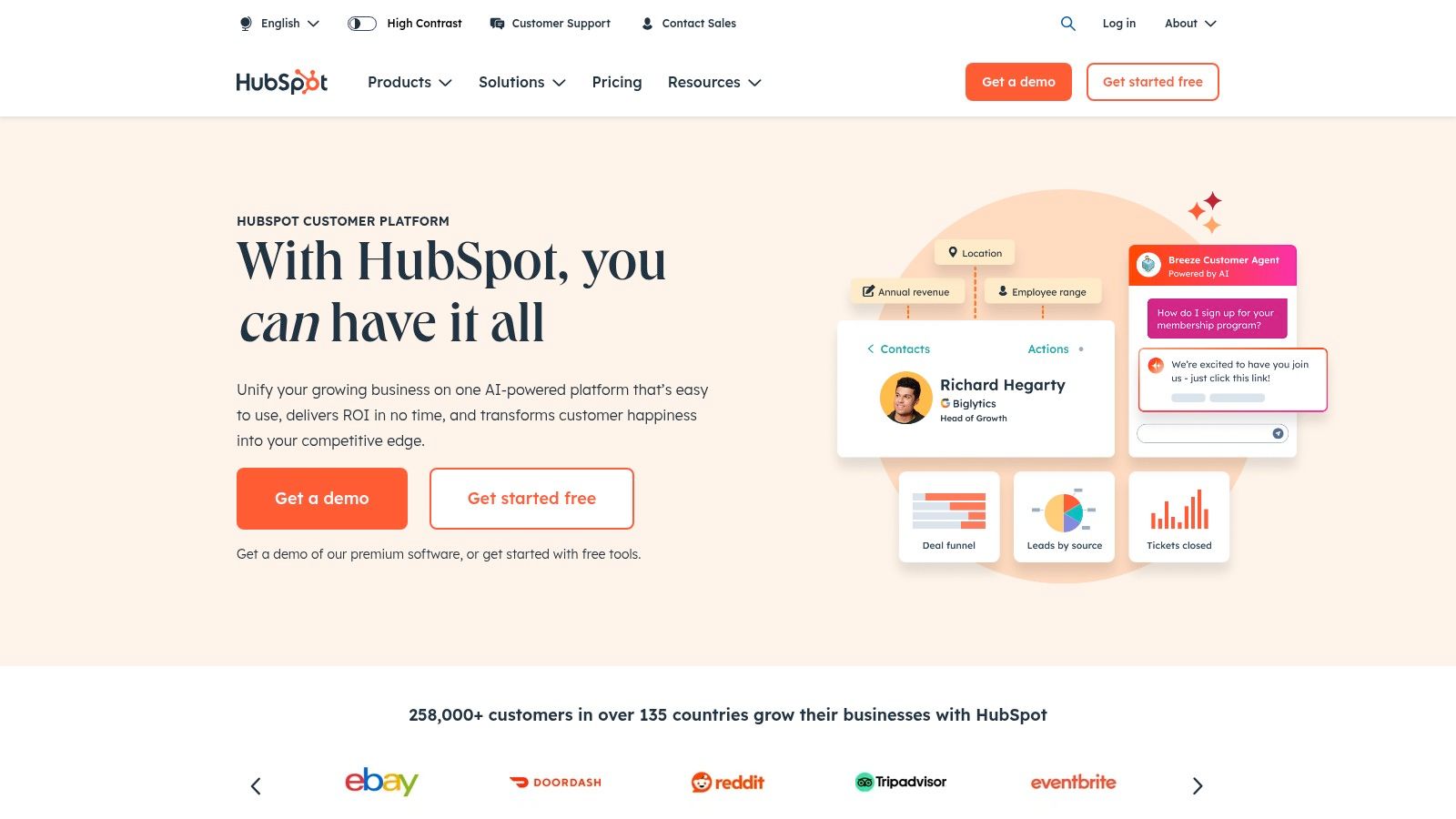
The platform's strength lies in its robust free-forever plan and its ability to act as a single source of truth for all customer interactions. From your Gmail window, you can track email opens, log communications automatically to a contact's record, access contact details from your CRM, and use productivity-boosting templates and sequences. It strikes a balance between ease of use for daily tasks and deep functionality for strategic growth.
Key Features and Benefits
- Deep Gmail Integration: The HubSpot Sales extension allows you to track email opens and clicks, schedule emails to send later, and access CRM contact data without leaving your inbox.
- Comprehensive Contact Management: Every interaction is automatically logged on a rich timeline, giving you a complete history of calls, emails, meetings, and notes for every contact and company.
- Sales Pipeline Visualization: Easily create and manage deals in a visual pipeline. Drag-and-drop deals between stages and get an instant forecast of your sales performance.
- Productivity Tools: Leverage free tools like meeting scheduling, live chat, and email templates to streamline your workflow and engage with leads more effectively.
Practical Tip: Use HubSpot’s "Meeting Scheduler" tool to eliminate back-and-forth emails when booking appointments. Simply share a link that shows your availability, allowing prospects to book a time that works for them directly in your calendar.
Pricing and Plans
HubSpot’s Free CRM is one of the most generous on the market, including contact management, deal pipelines, email tracking, and the meeting scheduler for unlimited users. As your business scales, you can upgrade to the Sales Hub, with paid plans starting from the Starter tier at $15 per user/month, which adds more advanced features. The Professional ($90 per user/month) and Enterprise ($150 per user/month) plans unlock sales automation, advanced reporting, and team management capabilities.
Pros & Cons
| Pros | Cons |
|---|---|
| Extremely generous and powerful free plan | Can become complex for users needing only basic features |
| Highly scalable for growing businesses | Advanced features are locked behind higher-priced plans |
| Extensive library of educational resources | The interface can feel overwhelming for new users |
| All-in-one marketing, sales, and service platform |
For businesses seeking a robust foundation for growth, HubSpot provides a powerful and integrated solution. To explore how it fits within the broader Google ecosystem, you can learn more about Google Workspace CRM options.
Website: https://www.hubspot.com/
4. Copper CRM
Copper CRM is purpose-built for businesses that operate within the Google Workspace ecosystem, positioning itself as the recommended CRM for Google. Rather than just integrating with Gmail, it creates a deeply embedded experience where your CRM data lives alongside your emails, calendar events, and contacts. This makes it a premier gmail crm system for teams that prioritize ease of use and want to eliminate manual data entry, allowing them to focus on building relationships instead of managing software.

The platform's primary appeal is its ability to automatically scrape contact information, communication history, and files from Gmail and add them to the relevant contact or deal record. This automation ensures your CRM is always up-to-date with minimal effort. Its clean, Google-inspired interface means there is almost no learning curve for users already familiar with Google Workspace apps.
Key Features and Benefits
- Native Google Workspace Integration: Copper functions like a natural part of Gmail, Google Calendar, and Google Drive, providing a seamless workflow without switching tabs.
- Automated Data Entry: Automatically captures contacts, emails, and files from your inbox, drastically reducing the time spent on administrative tasks.
- Visual Sales Pipeline: Manage leads and opportunities with an intuitive drag-and-drop pipeline, giving you a clear, visual overview of your entire sales process.
- Task Automation and Reminders: Set up automated workflows to assign tasks, send follow-up reminders, and keep deals moving forward, ensuring no opportunity falls through the cracks.
- Customizable Reporting: Build detailed reports and dashboards to track key metrics like pipeline progression, team performance, and sales forecasting.
Practical Tip: Connect Copper with Google Calendar to automatically link meetings to specific contacts and deals. This ensures that every scheduled interaction is tracked within the CRM, providing a complete 360-degree view of your client relationships.
Pricing and Plans
Copper does not offer a free plan but provides a 14-day free trial for all tiers. The Basic plan starts at $23 per user/month, offering core CRM functionalities and Google Workspace integration for up to 3 users. The Professional plan at $59 per user/month adds workflow automation, email sequences, and reporting features. For larger teams needing advanced capabilities, the Business plan at $99 per user/month includes team goals, lead scoring, and more customization options.
Pros & Cons
| Pros | Cons |
|---|---|
| Unmatched native Google Workspace integration | No free plan available |
| Automates nearly all data entry tasks | Higher price point compared to some competitors |
| Very intuitive and easy to use | Limited customization on lower-tier plans |
| Excellent for collaboration in Google-centric teams |
For teams deeply invested in the Google ecosystem, Copper offers a powerful and frictionless way to manage customer relationships directly from their daily tools.
Website: https://www.copper.com/
5. NetHunt CRM
NetHunt CRM positions itself as a powerful gmail crm system that integrates seamlessly with your inbox and the entire Google Workspace suite. It adds a full-featured CRM layer directly onto your Gmail interface, allowing sales and business teams to manage contacts, track deals, and automate workflows without ever leaving their familiar email environment. This deep integration is perfect for small to medium-sized businesses that rely heavily on Google's ecosystem and want to centralize customer data.
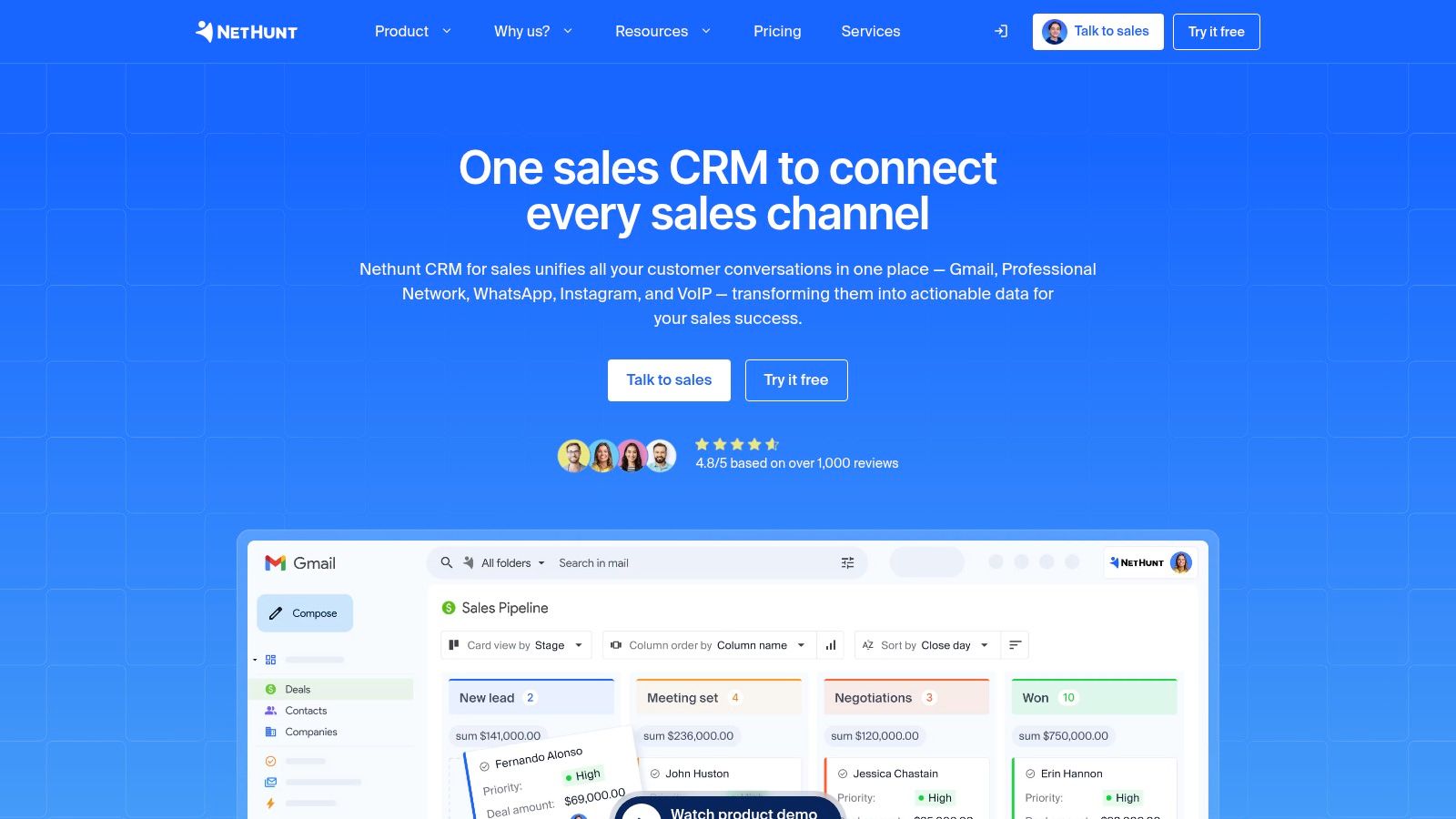
Unlike some simpler plugins, NetHunt organizes all customer information, conversations, and deal-related files into comprehensive records accessible from your inbox. A key differentiator is its ability to link emails to specific deals and contacts automatically, creating a clean, chronological timeline of every interaction. This ensures your entire team has a unified view of the customer journey.
Key Features and Benefits
- Deep Google Workspace Integration: Beyond Gmail, NetHunt connects with Google Contacts, Calendar, and Drive, creating a truly unified workspace where data is synced across all apps.
- Email Campaign Management: Send, track, and analyze bulk email campaigns directly from Gmail. Features include email tracking, templates, and performance reporting to optimize your outreach efforts.
- Workflow Automation: Automate routine tasks like data entry, lead nurturing sequences, and follow-up reminders. Workflows can be triggered by specific actions, such as a deal moving to a new stage.
- Customizable CRM Fields: Tailor your CRM records with custom fields to capture the exact information your business needs, ensuring the system adapts to your unique sales process.
Practical Tip: Use NetHunt's "Workflows" to automatically create a follow-up task in your Google Calendar whenever a deal is moved to the "Proposal Sent" stage. This ensures no opportunity slips through the cracks and keeps your sales cycle moving forward.
Pricing and Plans
NetHunt offers a 14-day free trial on all its plans. The Basic plan starts at $24 per user/month, offering core CRM features and 2,500 records. For growing teams, the Business plan at $48 per user/month adds advanced features like email marketing automation and sales forecasting. The Advanced plan at $96 per user/month provides full automation capabilities and dedicated support.
Pros & Cons
| Pros | Cons |
|---|---|
| Excellent, deep integration with Google Workspace | Some advanced features require technical setup |
| Highly flexible and customizable for various needs | The free plan is quite limited in functionality |
| Affordable pricing for SMBs | Can feel complex for users new to CRM concepts |
| Powerful workflow automation features |
For businesses embedded in the Google ecosystem, NetHunt CRM offers a robust and highly integrated solution that turns Gmail into a command center for sales and customer relations.
Website: https://nethunt.com/
6. Pipedrive CRM
Pipedrive CRM is a sales-first platform designed to help teams visualize and manage their sales processes with exceptional clarity. While not built directly into Gmail, its powerful two-way sync and dedicated Chrome extension create a deeply integrated experience, making it a stellar gmail crm system for sales professionals who need robust pipeline management without sacrificing email efficiency. It excels at helping users focus on activities that close deals, turning your inbox into a command center for your sales funnel.
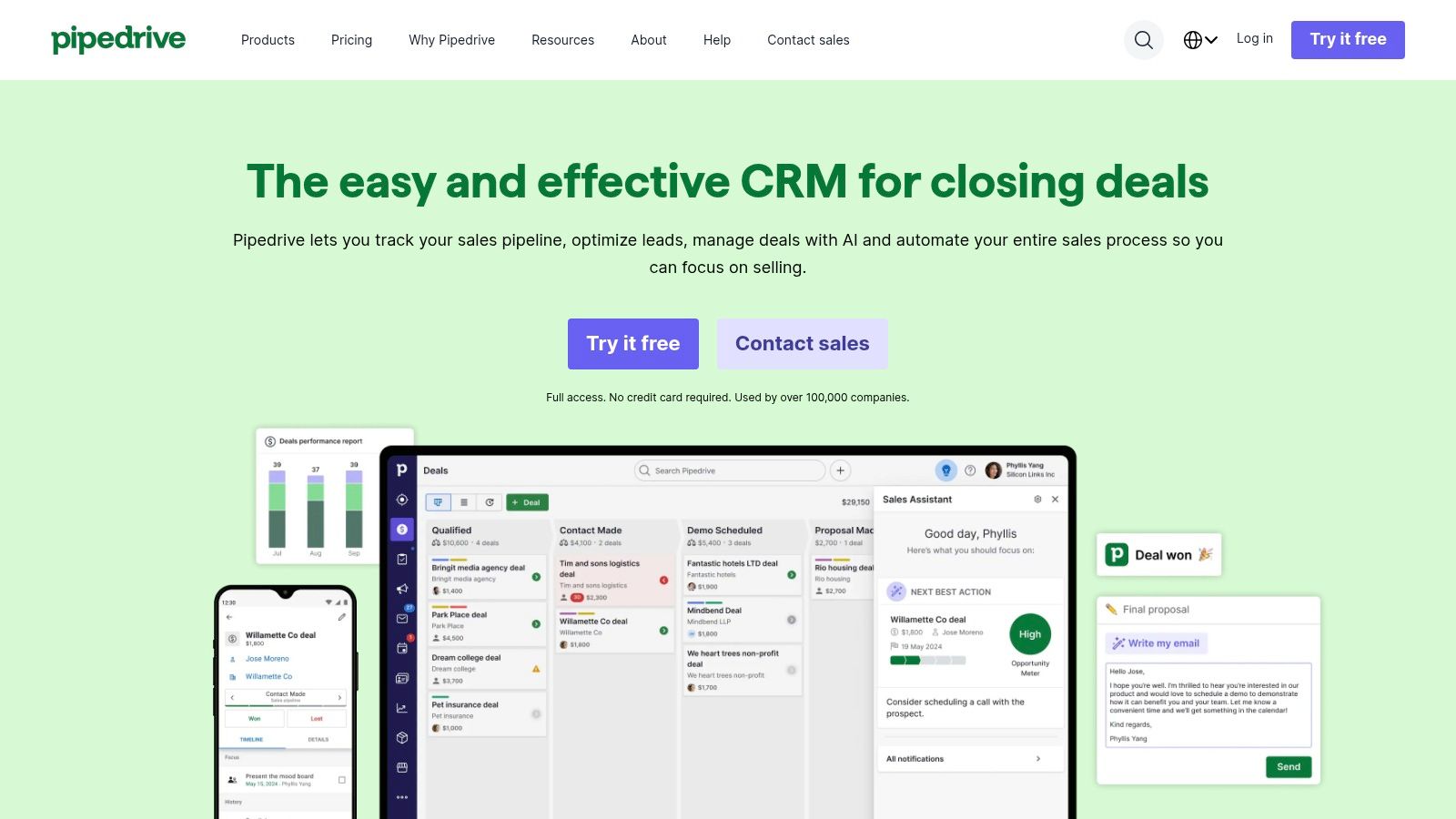
The platform's core philosophy is built around its visual sales pipeline. This drag-and-drop interface allows you to see the exact stage of every deal, prompting you with the next best action to take. The Gmail integration lets you sync emails, contacts, and calendar events, ensuring all communication is logged automatically to the correct contact or deal in Pipedrive, eliminating manual data entry.
Key Features and Benefits
- Visual Sales Pipeline: Intuitively track deals with a clear, drag-and-drop interface. Customize stages to match your sales process and get an instant overview of your team's progress.
- Seamless Email Integration: Use the "Sales Inbox" to manage emails with features like templates, tracking (opens and clicks), and scheduling directly from Pipedrive or your Gmail account.
- Activity-Based Selling: Pipedrive's methodology prompts you to schedule your next activity (a call, email, or meeting) for every deal, ensuring no opportunity falls through the cracks.
- Powerful Automation: Automate repetitive administrative tasks, such as creating activities or moving deals to the next stage, freeing up your team to focus on selling.
Practical Tip: Use Pipedrive’s "Scheduler" feature to share your availability with prospects via a link. This allows them to book a meeting directly in your calendar, which then syncs with both Pipedrive and Google Calendar, streamlining the appointment-setting process.
Pricing and Plans
Pipedrive does not offer a free plan, but it provides a 14-day free trial for all tiers. Plans begin with the Essential plan at $14 per user/month, offering core pipeline management and contact organization. The Advanced plan ($29 per user/month) adds full email sync, automation, and more customization. The Professional plan ($49 per user/month) includes revenue forecasting and enhanced reporting, while the Enterprise plan ($99 per user/month) provides advanced security and custom onboarding.
Pros & Cons
| Pros | Cons |
|---|---|
| Highly intuitive and user-friendly interface | Limited marketing automation features |
| Strong focus on sales pipeline management | No free plan is available |
| Extensive integration with third-party apps | Can become costly for larger teams |
| Excellent mobile app for on-the-go access |
For teams that live and breathe sales, Pipedrive offers an unbeatable combination of pipeline visualization and seamless Gmail integration that drives action and closes deals.
Website: https://www.pipedrive.com/
7. Zoho CRM
Zoho CRM is a powerhouse platform known for its extensive features and deep customization, making it a robust gmail crm system for businesses of all sizes. While not built into Gmail like some competitors, its integration is seamless, allowing you to sync contacts, view customer history, and manage deals directly from your inbox via a dedicated Chrome extension. This approach offers the best of both worlds: the familiarity of Gmail for communication and the comprehensive power of a standalone CRM for sales automation, analytics, and process management.
Zoho's strength lies in its scalability and the breadth of its ecosystem. It’s an ideal choice for businesses looking for a solution that can grow with them, offering everything from basic contact management to sophisticated, AI-powered sales forecasting. The Gmail integration ensures that all email correspondence is automatically logged against the correct contact or deal, keeping your records accurate and up-to-date without manual effort.
Key Features and Benefits
- Seamless Gmail Integration: Use the Zoho CRM for Gmail Chrome extension to add new leads, view contact details, and log emails directly from your inbox, streamlining your workflow.
- Powerful Sales Automation: Automate repetitive tasks with workflow rules, macros, and scheduled actions. Nurture leads, score them based on engagement, and assign them to the right sales reps automatically.
- Advanced Analytics: Generate detailed reports and dashboards to track sales performance, forecast revenue, and identify trends. Gain a 360-degree view of your entire sales cycle.
- Extensive Customization: Tailor modules, fields, layouts, and workflows to match your unique business processes. Zoho CRM is highly adaptable to fit industries from real estate to software.
Practical Tip: Use Zoho's "Macros" feature to execute a sequence of actions with a single click. For example, you can create a macro that sends a follow-up email, updates a deal stage, and creates a follow-up task simultaneously, saving valuable time on routine sales activities.
Pricing and Plans
Zoho offers an impressive Free plan for up to three users, which includes lead, contact, and deal management, making it perfect for small teams just starting. Paid plans begin with the Standard plan at $14 per user/month, adding scoring rules and workflow automation. The Professional plan ($23 per user/month) introduces real-time notifications and process management, while the Enterprise plan ($40 per user/month) unlocks advanced AI features and customization.
Pros & Cons
| Pros | Cons |
|---|---|
| Affordable pricing with a great free plan | User interface can feel complex for beginners |
| Extensive customization to fit any business need | Some advanced features are on higher-tier plans |
| Wide range of integrations within the Zoho ecosystem | The sheer number of features can be overwhelming |
| Excellent mobile app with offline access |
For businesses seeking a feature-rich, scalable, and highly customizable CRM that integrates cleanly with their inbox, Zoho CRM is an exceptional choice.
Website: https://www.zoho.com/crm/
Top 7 Gmail CRM Systems Comparison
| Product | Implementation Complexity 🔄 | Resource Requirements ⚡ | Expected Outcomes 📊 | Ideal Use Cases 💡 | Key Advantages ⭐ |
|---|---|---|---|---|---|
| Tooling Studio | Low - Chrome extension, near-native interface | Low - Runs within Google Chrome, minimal setup | Improved productivity with visual task management and collaboration | Teams and freelancers using Google Workspace | Native Google Workspace integration, Kanban UI, real-time collaboration, strong security |
| Streak CRM | Low - Built into Gmail | Low - Basic features free, higher-tier paid plans | Streamlined email-based CRM, basic pipeline management | Small teams and individuals needing simple CRM | Native Gmail integration, user-friendly, free basic plan |
| HubSpot CRM | Medium - Requires setup and learning | Medium to High - Free plan available, advanced paid features | Comprehensive sales and marketing management | Growing businesses needing scalable CRM suite | Comprehensive tools, extensive educational resources |
| Copper CRM | Medium - Google Workspace native | Medium to High - Paid plans needed for full features | Automated data entry, task automation for sales efficiency | Google Workspace users focusing on automation | Deep Google app integration, automation, intuitive UI |
| NetHunt CRM | Medium - Customizable, may need technical setup | Low to Medium - Affordable plans for SMBs | Flexible CRM with workflow automation and reporting | SMBs requiring affordable, customizable Gmail CRM | Flexible pipelines, Gmail integration, cost-effective |
| Pipedrive CRM | Low to Medium - Intuitive, visual pipeline | Medium - No free plan, paid subscriptions | Efficient sales process management and automation | Sales teams focusing on pipeline and task management | Visual pipeline, strong sales focus, third-party integrations |
| Zoho CRM | Medium to High - Rich feature set and customization | Medium - Free plan for small teams, paid tiers for advanced | Feature-rich CRM with automation and analytics | Small to large teams needing customizable CRM | Extensive customization, broad integration, affordable pricing |
Making Your Choice: How to Select the Right Gmail CRM System for You
Navigating the landscape of Gmail CRM systems can feel overwhelming, but the right choice ultimately comes down to aligning a tool’s core strengths with your team's specific operational needs. We've explored a range of powerful contenders, from the spreadsheet-inspired simplicity of Streak to the comprehensive sales automation of HubSpot and the deep Google Workspace integration of Copper. Each platform offers a unique approach to managing customer relationships directly within the familiar comfort of your inbox.
The key takeaway is that the most effective Gmail CRM system isn't necessarily the one with the most features. Instead, it's the one that seamlessly integrates into your existing workflows, reduces friction for your team, and provides clear, actionable insights that drive growth. A system that your team genuinely adopts and uses consistently will always outperform a more complex platform that gathers digital dust.
A Practical Framework for Your Decision
Before committing to a subscription, it’s crucial to move beyond feature lists and assess each tool against your practical, day-to-day requirements. Use this checklist as a final guide to clarify your priorities and make a confident decision.
1. Identify Your Primary Use Case:
- For Sales-Centric Teams: Are you managing a structured sales pipeline with distinct stages? Tools like Pipedrive or NetHunt CRM, with their visual pipeline focus and deal-tracking capabilities, are built for this purpose.
- For Relationship & Project Management: If your focus is less on transactional sales and more on long-term client relationships or project delivery, a flexible system like Tooling Studio or Streak might be ideal. Their customizable pipelines can be adapted for anything from hiring and support tickets to business development.
- For All-in-One Marketing & Sales: Do you need a system that connects your CRM data to broader marketing campaigns, landing pages, and email automation? The HubSpot CRM free plan offers an unbeatable entry point into a comprehensive ecosystem.
2. Evaluate the User Experience:
- Intuitive Adoption: How easy is it for a new user to understand the interface without extensive training? A truly integrated Gmail CRM system should feel like a natural extension of Gmail, not a clunky add-on.
- Minimal Context Switching: The goal is to stay in your inbox. Consider how much you'll need to click out to the main web app versus what you can accomplish directly within the Gmail side panel.
3. Assess Integration and Scalability:
- Google Workspace Synergy: Beyond Gmail, how well does the CRM integrate with Google Calendar, Drive, and Sheets? Copper and NetHunt CRM often lead in this category, offering deep, native-feeling connections.
- Future Growth: Consider where your business will be in one or two years. Will this CRM grow with you? Look at the higher-tier plans and third-party integration options (like Zapier) to ensure the platform can scale alongside your ambitions. For a broader perspective on tools that support business growth, you can find helpful comparisons in this guide to the Best CRM for Small Business Solutions, which can further inform your decision-making process.
By methodically working through these points and taking advantage of free trials, you can move from analysis to action. The perfect Gmail CRM system is waiting to transform your inbox from a chaotic communication channel into a centralized, intelligent command center for your business relationships.
Ready to unify your tasks, projects, and client communication directly within Google Workspace? Tooling Studio transforms your Gmail and Google Drive into a powerful, centralized hub for all your work. Try Tooling Studio today to experience a truly integrated workflow and see how it can streamline your team’s productivity.